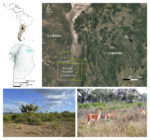Estado de conservación de la última población de guanacos chaqueños de Argentina: un abordaje transdisciplinar
Fernando R. Barri, Jessica Manzano García, M. Paula Weihmüller, Thiago CostaDentro de las subpoblaciones de guanacos (Lama guanicoe), algunas se encuentran en peligro crítico de extinción. Es el caso particular del guanaco chaqueño, que habitó amplias extensiones de esta gran ecorregión hasta principios del siglo XX. A partir de información que ubicaba a la especie en la región de las Salinas Grandes del centro de Argentina, se realizó un estudio transdisciplinar. Después de siete años de muestreos, se caracterizó la historia reciente de esta población, se estimó su tamaño y el área de su distribución. En la actualidad, el número de guanacos que persiste es inferior a los 80 individuos, y se encuentran restringidos a un área peri-salina y zonas aledañas de un gran campo ganadero que prohíbe su cacería, principal impacto antrópico que redujo a esta población en el pasado reciente. Si bien existen aspectos alentadores para su conservación, como la reciente creación del Parque Nacional Traslasierra, es necesario profundizar las medidas de manejo tendientes a aumentar el tamaño y la distribución del guanaco chaqueño, así como también generar acciones que permitan revalorizar su existencia como recurso biocultural.
Conservation status of the last guanacos’ Chaqueñan population in Argentina: a transdisciplinary approach. Within the subpopulations of guanacos (Lama guanicoe), some are in critical danger of extinction. This is the case of the Chaqueñan guanaco, which inhabited large areas of this great ecoregion until the beginning of the 20th century. Based on the information that located the species in the Salinas Grandes of central Argentina, a transdisciplinary study was conducted. After seven years of field studies, the recent history of this population was characterized, and its population size and area of distribution were estimated. Currently, the number of guanacos that persists is less than 80 individuals, being restricted to the peri-saline and surrounding areas of a large cattle ranch that prohibits hunting, the main anthropic impact that reduced this population in the recent past. Although there are encouraging aspects for its conservation, such as the recent creation of the Traslasierra National Park, it is necessary to deepen management measures to increase the size and distribution of the Chaco guanaco, as well as generate actions that allow revaluing its existence as a biocultural resource.

